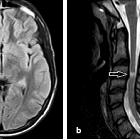double inversion recovery sequence
Double inversion recovery (DIR) is an inversion recovery MRI pulse sequence that uses two different inversion pulses. The technique can be used to suppress signal from two different tissues or to suppress signal that moved between the two pulses.
In the first instance, used in neuroimaging, two inversion times are selected to suppress signal from cerebrospinal fluid (e.g. TI1 = 2000-3000 ms before readout) and from white matter (e.g. TI2 = 450 ms before readout). On T2 weighted images, this method increases the conspicuity of white matter plaques in multiple sclerosis. It is useful to help estimate lesion load, differentiate juxtacortical from mixed grey matter-white matter plaques, and detect infratentorial or spinal cord lesions.
In the second instance, used in cardiovascular imaging, two inversion pulses are generated in close temporal proximity near the null point for blood (e.g. TI = 650 ms), but the first is nonselective while the second is slice selective. The first pulse inverts the magnetization in the entire volume and the second returns positive magnetization in the slice imaged. By the time the readout occurs, blood that had inverted magnetization has moved into the imaged slice and appears dark. This is a method of "black blood" or "dark blood" imaging. It is useful to improve the conspicuity of lesions in the vessel wall or myocardium.
Siehe auch:
- Encephalomyelitis disseminata
- MAGNIMS consensus on MRI diagnosis of multiple sclerosis
- IR - inversion recovery
und weiter:

 Assoziationen und Differentialdiagnosen zu double inversion recovery sequence:
Assoziationen und Differentialdiagnosen zu double inversion recovery sequence:
